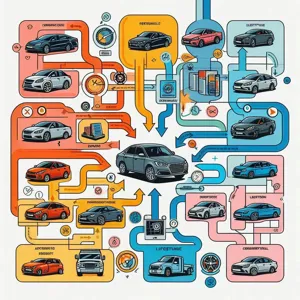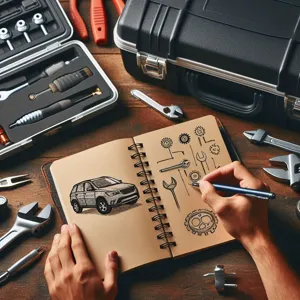Selecting the right car is more than just a financial decision; it’s a reflection of your lifestyle, needs, and personal preferences.
With the automobile market brimming with choices, from compact sedans to rugged SUVs and eco-friendly hybrids, the process can feel overwhelming. Should you prioritize fuel efficiency for daily commutes, or is spaciousness for family outings more important? Perhaps you’re an adventure seeker in need of a vehicle that can handle off-road excursions. In this comprehensive guide, we will explore the essential factors to consider when choosing the perfect car for your unique driving lifestyle. By analyzing your daily routines, budget, and long-term goals, you’ll be empowered to navigate your options and ultimately find the vehicle that not only meets your practical needs but also complements your passions and aspirations. Buckle up as we embark on this journey to discover the ideal ride for you!
1. Understanding Your Driving Lifestyle

Choosing the right car is more than just picking a model that catches your eye; it’s about aligning your vehicle with your unique driving lifestyle. To make an informed decision, start by delving into the specifics of how you plan to use your car daily. Consider your primary driving habits: Are you commuting to work in bustling city traffic, embarking on long road trips, or navigating rugged terrains for weekend adventures? Each scenario calls for distinct vehicle characteristics.
For city dwellers, a compact car might be the ideal choice, offering agility for maneuvering through tight spaces and fuel efficiency for daily commutes. On the other hand, if you regularly transport family or friends, a spacious SUV or a minivan could provide the comfort and roominess you need. For those with a love for adventure, a rugged 4×4 may be essential for tackling off-road trails or navigating challenging weather conditions.
Next, think about your lifestyle needs. Do you frequently haul equipment for work, or perhaps you have hobbies that require extra cargo space, like cycling or camping? Your vehicle should not only accommodate your daily tasks but also enhance your hobbies and interests. Additionally, consider your budget for maintenance and fuel; some vehicles are more economical than others, which can significantly impact your overall ownership experience.
Lastly, don’t overlook the emotional aspect of car ownership. Ask yourself how you want your vehicle to make you feel. Whether it’s the thrill of driving a sporty coupe or the peace of mind that comes with a reliable family car, your choice should resonate with your personal values and lifestyle desires. By taking the time to evaluate your driving lifestyle, you’ll be well on your way to finding the perfect car that fits seamlessly into your life.
2. Assessing Your Daily Commute Needs
When it comes to selecting the perfect car, one of the most critical factors to consider is your daily commute. This seemingly simple assessment can have a significant impact on your overall driving experience and long-term satisfaction with your vehicle. Start by asking yourself a few key questions: How far do you travel each day? What type of terrain do you navigate—urban streets, winding country roads, or perhaps a mix of both? Understanding the specifics of your commute will help you hone in on the right car that aligns with your lifestyle.
If you find yourself making a short, city-based trek, a compact car or a hybrid model could be ideal. These vehicles offer excellent fuel efficiency and are nimble enough to weave through tight traffic, making them perfect for bustling metropolitan areas. On the other hand, if your daily route involves long highway stretches, a comfortable sedan or an efficient crossover SUV might be better suited to provide the smooth ride and extra space you need for longer journeys.
Additionally, consider the frequency and nature of your commute. Do you often carpool with colleagues, or do you have family members to transport? If so, a car with ample seating and cargo space will be essential. Features like advanced safety systems and technology amenities can also enhance your daily drive, making it more enjoyable and efficient.
Finally, take some time to evaluate your budget in relation to your commute. The cost of fuel, insurance, and maintenance can vary significantly between different types of vehicles. By aligning your car choice with your commuting needs and financial situation, you’ll not only make a sound investment but also ensure that your daily driving experience is as comfortable and hassle-free as possible. In the end, the right vehicle will seamlessly integrate into your lifestyle, making every journey a pleasure rather than a chore.
3. Identifying Key Features: What Matters Most?

When it comes to choosing the perfect car, identifying key features that align with your driving lifestyle is paramount. With a myriad of options available, it’s easy to get lost in the sea of specifications and stylish designs. However, taking a moment to reflect on what truly matters to you can streamline the decision-making process and lead you to a vehicle that complements your everyday life.
Start by considering your primary needs. Do you frequently commute long distances for work? If so, fuel efficiency and comfort become essential factors. Look for models that offer excellent gas mileage and spacious interiors, allowing you to tackle those lengthy drives without feeling fatigued. Alternatively, if you enjoy weekend getaways or outdoor adventures, you might prioritize all-wheel drive capabilities, cargo space, and resilience in various weather conditions.
Safety features should also be high on your checklist. Advanced driver-assistance systems (ADAS), such as lane-keeping assist, adaptive cruise control, and automatic emergency braking, can enhance your confidence on the road, providing peace of mind for both you and your passengers. Always check for crash test ratings and reviews, as they can give you insight into how well a car performs in real-world situations.
Don’t forget about the tech features that can enhance your driving experience. Modern vehicles often come equipped with infotainment systems that integrate seamlessly with your devices, offering navigation, hands-free calling, and music streaming. These conveniences can turn mundane drives into enjoyable experiences, so consider what tech features are essential for your daily routine.
Lastly, think about the long-term. Your car is an investment, and understanding your lifestyle now and how it might evolve in the coming years can help you avoid buyer’s remorse. Whether you’re planning to start a family, move closer to work, or even explore new hobbies, choose a vehicle that can adapt to your changing needs.
In summary, identifying key features that resonate with your specific driving lifestyle is crucial in navigating your options. By focusing on your needs—be it efficiency, safety, technology, or adaptability—you’ll be well on your way to selecting a car that not only meets your current demands but also grows with you over time.
4. The Importance of Fuel Efficiency
When it comes to selecting the perfect car for your driving lifestyle, fuel efficiency is a critical factor that cannot be overlooked. In today’s world, where gas prices fluctuate unpredictably and environmental concerns are at the forefront of many consumers’ minds, choosing a vehicle that conserves fuel can result in significant savings and a reduced carbon footprint.
Imagine your daily commute: whether it’s a quick trip to the office or a longer journey across town, a fuel-efficient car helps you stretch your budget further, allowing you to spend less time at the pump and more time enjoying the open road. For urban dwellers, small, economical cars can navigate tight streets and congested traffic with ease, while hybrid or electric vehicles offer the ultimate in efficiency, providing a seamless driving experience without the constant worry of gas prices.
Moreover, fuel efficiency isn’t just about cost savings; it also enhances your driving lifestyle. Picture embarking on a weekend adventure with friends or family, knowing that your vehicle can take you further on a single tank of gas. The less you spend on fuel, the more you can allocate towards experiences—whether that’s a scenic road trip or a spontaneous getaway.
In addition to practical benefits, opting for a fuel-efficient vehicle aligns with a growing consumer desire for sustainability. Many manufacturers now prioritize eco-friendly technologies, ensuring that your choice contributes positively to the environment. By investing in fuel efficiency, you’re not only making a smart financial decision but also advocating for a cleaner, greener future.
As you navigate your options, consider how fuel efficiency aligns with your driving habits and lifestyle preferences. After all, the right vehicle should enhance your life, whether that means saving money, reducing your environmental impact, or simply enjoying the journey ahead.
5. Exploring Different Vehicle Types: Sedans, SUVs, and More

When it comes to choosing the perfect car for your driving lifestyle, understanding the various vehicle types available is crucial. Each category offers its own unique set of advantages, catering to different needs, preferences, and driving conditions.
**Sedans** are often the go-to choice for urban dwellers and those who prioritize efficiency and ease of maneuverability. With their sleek design and typically better fuel economy, sedans offer a comfortable ride for daily commutes and city driving. They are generally compact, making them easier to park in tight spaces, and they often come equipped with a range of advanced technology features that enhance the driving experience. If you’re someone who enjoys a smooth, controlled ride with an emphasis on practicality, a sedan might be your ideal match.
On the other hand, **SUVs (Sport Utility Vehicles)** have gained immense popularity in recent years, thanks to their versatility and spacious interiors. Perfect for families or anyone who regularly transports gear—think camping equipment or sports gear—SUVs provide ample cargo space and passenger room. Many models come with all-wheel drive systems, making them suitable for both city streets and off-road adventures. If outdoor excursions or family road trips are part of your lifestyle, an SUV could provide the support and comfort you need.
Then there are **crossovers**, which blend the best features of sedans and SUVs. They typically have the higher ride height and spaciousness of an SUV while maintaining the handling characteristics of a car. This makes them an excellent option for those who want a bit of everything—comfort, versatility, and efficiency.
For those who lean towards performance and sporty driving, **coupes** and **convertibles** offer an exhilarating experience, with a focus on speed and aesthetics. They may sacrifice some practicality for style, but for enthusiasts, the thrill of the drive can make it all worthwhile.
Lastly, **trucks** stand out for their unparalleled utility. If you require a vehicle that can haul heavy loads or navigate rugged terrain, trucks are built to handle the challenge. They offer impressive towing capacities and a rugged design, making them ideal for work and outdoor activities.
As you explore these different vehicle types, consider your driving habits, the number of passengers you typically carry, and any specific needs that align with your lifestyle. By identifying what matters most to you—be it fuel efficiency, cargo space, or performance—you can narrow down your options and find the vehicle that fits seamlessly into your life.
6. New vs. Used: Pros and Cons of Each Option
When it comes to choosing between a new or used car, the decision often boils down to your personal preferences, budget constraints, and driving lifestyle. Both categories offer unique advantages and potential drawbacks, making it essential to weigh the pros and cons before making a commitment.
**New Cars: The Allure of Fresh Beginnings**
Purchasing a new car comes with the undeniable thrill of driving a vehicle that is pristine, technologically advanced, and often equipped with the latest safety features. New cars typically come with comprehensive warranties, offering peace of mind against unforeseen repairs. Additionally, they tend to have better fuel efficiency and lower emissions, aligning with environmentally-conscious driving habits. However, this luxury comes at a cost. New cars depreciate rapidly, losing a significant percentage of their value within the first few years. The initial purchase price can also be a considerable financial burden, especially when factoring in taxes, fees, and higher insurance rates.
**Used Cars: Budget-Friendly Versatility**
On the other hand, used cars present an appealing alternative for budget-conscious buyers. They generally come at a lower price point, allowing you to explore higher-end models or additional features that might be out of reach when buying new. A well-maintained used car can also hold its value better than a new one, making it a savvy investment in the long run. However, purchasing used does come with its own set of challenges. The vehicle’s history, including potential accidents or mechanical issues, may not always be transparent, and you might face higher maintenance costs if the car is older. Additionally, used cars may lack the latest technology and safety advancements, which can be a critical factor for some drivers.
Ultimately, the choice between new and used cars hinges on your driving lifestyle and financial situation. Consider how often you drive, the distances you travel, and whether you prioritize the latest features or value for money. By weighing the pros and cons of each option, you can find the vehicle that not only fits your budget but also enhances your driving experience.
7. Considering Safety Ratings and Features

When selecting the perfect car to complement your driving lifestyle, considering safety ratings and features is not just a prudent choice—it’s an essential one. In an age where technology and innovation converge to enhance vehicle safety, understanding these ratings can significantly influence your decision-making process.
Safety ratings, often provided by organizations such as the National Highway Traffic Safety Administration (NHTSA) and the Insurance Institute for Highway Safety (IIHS), offer a comprehensive overview of how well a car performs in crash tests and its ability to protect occupants in various situations. A higher safety rating is a clear indicator that a vehicle can better withstand accidents, providing peace of mind whether you’re commuting through busy city streets or embarking on long road trips.
But safety extends beyond just crash test results. Modern vehicles come equipped with a plethora of advanced safety features that can act as your first line of defense against potential hazards. From adaptive cruise control and lane departure warnings to automatic emergency braking and blind-spot monitoring, these technologies work in unison to create a safer driving experience. When test-driving a potential vehicle, take the time to explore these features and understand how they function; knowing that your car can help you navigate unexpected situations can significantly enhance your confidence on the road.
Additionally, consider the vehicle’s design and structural integrity. A well-built car with a solid frame can better absorb impact during a collision, while features like crumple zones and reinforced passenger cabins can provide extra protection for you and your loved ones.
In summary, as you navigate your options in choosing the ideal vehicle, don’t overlook the critical aspect of safety ratings and features. A car that prioritizes safety not only protects you in an emergency but also contributes to a more enjoyable driving experience, allowing you to focus on the journey ahead instead of worrying about potential dangers. Make it a point to research and evaluate these factors thoroughly, ensuring that your next vehicle aligns perfectly with your driving lifestyle and safety needs.
8. Budgeting for Your Purchase: Total Cost of Ownership
When it comes to choosing the perfect car for your driving lifestyle, understanding the total cost of ownership is crucial. It’s not just about the sticker price; the financial commitment extends far beyond that initial purchase. As you embark on this journey, take a deep dive into the various factors that contribute to the long-term expenses associated with your vehicle.
First and foremost, consider fuel efficiency. Different cars offer varying miles per gallon (MPG) ratings, and this can significantly impact your monthly budget. If you’re commuting daily or embarking on road trips, a vehicle that sips fuel rather than guzzles it can save you a substantial amount over time.
Next, don’t overlook insurance costs. Factors such as the make and model of the car, your driving history, and even your location can influence your premiums. It’s wise to obtain insurance quotes for the models you’re considering to ensure they fit within your financial framework.
Maintenance is another critical component. Some vehicles require more frequent service or specialized parts, which can elevate costs. Research the reliability ratings of your prospective cars and look into the average maintenance costs associated with each. Websites and forums dedicated to car enthusiasts can provide invaluable insights from real owners about the long-term upkeep of specific models.
Additionally, think about depreciation. While all cars lose value over time, some models retain their worth better than others. If you plan on selling or trading your car in a few years, selecting a model known for its resale value can cushion the blow of depreciation.
Lastly, factor in taxes, registration fees, and any potential financing costs. These hidden expenses can quickly add up, making it essential to have a comprehensive understanding of what you’ll be paying before finalizing your purchase.
By carefully evaluating these elements, you can make an informed decision that aligns with your budget and driving lifestyle, ensuring that your new vehicle is not just a purchase today but a wise investment for the future.
9. The Role of Technology in Modern Vehicles
In today’s automotive landscape, technology plays an increasingly pivotal role in shaping the driving experience, offering not just convenience but also enhancing safety and efficiency. Modern vehicles are equipped with a plethora of advanced features that can significantly impact your choice, depending on your driving lifestyle.
One of the most notable advancements is the integration of infotainment systems, which seamlessly connect your smartphone to your car. These systems often come with voice recognition, navigation, and music streaming capabilities, allowing for hands-free operation and minimizing distractions while driving. Imagine being able to navigate through traffic using real-time updates or enjoying your favorite playlist without fumbling for your phone—this level of connectivity makes for a more enjoyable and efficient journey.
Safety technology has also reached remarkable heights. Features such as adaptive cruise control, lane-keeping assist, and automatic emergency braking are becoming standard in many new models. These innovations not only provide peace of mind, especially for those who spend long hours on the road, but they also help to prevent accidents, making the driving experience safer for everyone. Consider how often you find yourself in heavy traffic or navigating unfamiliar areas; having these safety nets can significantly reduce stress and enhance your confidence behind the wheel.
Moreover, advancements in electric and hybrid vehicle technology are transforming the conversation around fuel efficiency and environmental impact. If you’re an eco-conscious driver or someone looking to reduce fuel costs, exploring electric vehicles (EVs) or hybrids could be a game-changer. With charging infrastructure steadily improving, more drivers are finding that the transition to an electric vehicle is not only feasible but also rewarding.
As you evaluate your options, it’s crucial to consider how these technological advancements align with your unique driving needs. Whether you prioritize entertainment, safety, or sustainability, understanding the role of technology in modern vehicles can guide you toward making a choice that enhances your lifestyle rather than complicates it. Embrace the innovation that modern cars offer, and you’ll find a vehicle that truly complements your driving habits.
10. Test Driving: What to Look For
When it comes to choosing the perfect car for your driving lifestyle, the test drive can be one of the most revealing and crucial steps in the decision-making process. This is your opportunity to experience the vehicle firsthand, so it’s essential to approach it with a keen eye and a checklist of what to look for.
Start by paying attention to the comfort of the seating. As you settle into the driver’s seat, notice how the seat feels against your back and thighs. Is it supportive and adjustable? Can you find a comfortable driving position easily? If you plan on long commutes or road trips, comfort should be a top priority.
Next, evaluate visibility. Look out the windows and check the mirrors—are blind spots an issue? Can you see the road clearly without straining? Good visibility enhances safety and confidence while driving.
As you pull away, listen carefully to the engine and any other sounds the car makes. A smooth, quiet engine is a sign of a well-maintained vehicle, while unusual noises can be a red flag. Pay attention to how the car accelerates and brakes; it should respond promptly and smoothly without hesitation.
Handling is another critical aspect. Take the car through a few turns and evaluate its stability and responsiveness. Does it hug the road, or does it feel wobbly? If you’re considering a sportier model, you’ll want to feel that connection with the road beneath you.
Lastly, assess the technology and features. Familiarize yourself with the infotainment system, controls, and connectivity options. Are they intuitive and easy to use? Consider how these features align with your lifestyle—do you need advanced navigation, Bluetooth connectivity, or safety features like lane-keeping assist?
Taking the time to test drive with these factors in mind can provide valuable insights that specifications and reviews simply can’t offer. By the end of your test drive, you’ll be better positioned to choose a vehicle that not only fits your needs but also enhances your driving experience.
11. Researching and Comparing Models
When it comes to choosing the perfect car for your driving lifestyle, research and comparison are your best allies. The vast array of models available today can be overwhelming, but taking the time to dig deep into the details will empower you to make an informed decision that aligns with your needs and preferences.
Start by identifying your priorities. Are you looking for fuel efficiency for your daily commute, or do you need a spacious SUV for family road trips? Make a list of must-have features such as safety ratings, technology integration, cargo space, and driving comfort. Once you have a clear picture of what you need, it’s time to hit the books—or the web.
Utilize online resources such as automotive review websites, manufacturer specifications, and user forums. These platforms offer comprehensive insights into various models, helping you understand how they perform in real-world conditions. Pay attention to expert reviews that assess aspects like handling, reliability, and maintenance costs, as well as customer feedback that can reveal both the pros and cons of ownership.
Don’t overlook the importance of comparing models side by side. Many automotive websites offer comparison tools that allow you to juxtapose multiple vehicles based on their specifications, features, and pricing. This visual aid can be particularly helpful in clarifying which models truly stand out in your price range and fulfill your requirements.
Finally, make a point to visit local dealerships for test drives. Experiencing how a car handles on the road is irreplaceable. Take your time to assess comfort, visibility, and overall driving dynamics. Each model will have its unique feel, and a test drive can often illuminate aspects you may not have considered during your research.
By dedicating time to thorough research and model comparisons, you’ll be well-equipped to navigate the myriad of choices available and find a car that enhances your driving lifestyle, ensuring every journey is a pleasure.
12. Understanding Financing and Leasing Options
When it comes to acquiring a vehicle, understanding your financing and leasing options can be the determining factor in making a choice that aligns with your driving lifestyle and budget. The landscape of car financing is vast, offering various paths to vehicle ownership, each with its own set of advantages and considerations.
Financing a car typically involves taking out a loan to purchase the vehicle outright. This means you’ll own the car once the loan is paid off, allowing you the freedom to customize it, drive as much as you want without worrying about mileage limits, and sell or trade it in whenever you choose. However, it’s essential to evaluate factors such as interest rates, loan terms, and monthly payments to ensure that the financial commitment fits comfortably within your budget. Many lenders offer a range of financing options, so shopping around can help you secure the best deal.
On the other hand, leasing a car is akin to renting; you essentially pay for the vehicle’s depreciation over a specific period, typically two to three years. Leasing often comes with lower monthly payments than financing, making it an attractive option for those who prefer driving a new car every few years without the long-term commitment of ownership. However, be mindful of the mileage limits that come with leasing contracts, as exceeding them can lead to costly penalties. Additionally, at the end of the lease, you’ll have to return the vehicle, which may not sit well with those who prefer to keep their cars long-term.
Both options have their merits, and the right choice depends largely on your driving habits, financial situation, and lifestyle preferences. For instance, if you enjoy the thrill of driving the latest models with the newest technology and don’t mind adhering to mileage restrictions, leasing might be the perfect fit. Conversely, if you value ownership and plan to keep your vehicle for many years, financing could be more suitable.
Ultimately, understanding the intricacies of both financing and leasing is crucial. Take the time to assess your priorities, compare offers, and consult with financial advisors if needed. With a clear understanding of your options, you can confidently navigate the car-buying process and select the vehicle that best complements your unique driving lifestyle.
13. The Impact of Environmental Considerations
In today’s world, environmental considerations have become an essential factor in choosing the perfect car for your driving lifestyle. As awareness about climate change and pollution rises, more drivers are seeking vehicles that align with their values and contribute to a sustainable future.
When evaluating your options, it’s important to think about the carbon footprint of the cars you’re considering. Traditional gasoline-powered vehicles emit a significant amount of greenhouse gases, while hybrid and electric vehicles offer a more eco-friendly alternative. Electric cars, for instance, produce zero tailpipe emissions and can be charged using renewable energy sources, drastically reducing their environmental impact.
However, it’s not just about the type of fuel a vehicle uses; consider the manufacturing processes and materials used in the car’s production. Many automakers are now prioritizing sustainable practices, from sourcing recycled materials to minimizing waste during manufacturing. Researching brands that are committed to environmental stewardship can help you make a more informed choice.
Additionally, think about your driving habits and how they relate to environmental impact. If you frequently commute in heavy traffic, a fuel-efficient vehicle or hybrid may be ideal. Conversely, if you enjoy road trips or off-road adventures, consider a vehicle that balances performance with eco-friendliness, such as a plug-in hybrid.
Ultimately, the impact of environmental considerations extends beyond just your choice of vehicle; it reflects your commitment to sustainability and responsible living. By choosing a car that aligns with these values, you not only enhance your driving experience but also contribute positively to the planet, ensuring a cleaner and greener future for all.
14. Tips for Negotiating the Best Price
Negotiating the best price for a car can often feel like a daunting task, but with the right strategies in your arsenal, you can confidently navigate the process and drive away with a deal that reflects your needs and budget. Here are some valuable tips to help you secure the best price for your next vehicle.
First and foremost, do your homework. Before stepping foot in a dealership, arm yourself with knowledge about the make and model you’re interested in, including its market value and any ongoing promotions. Websites like Kelley Blue Book and Edmunds provide invaluable information about pricing, helping you establish a solid baseline for negotiations. Knowing the fair price range will empower you during discussions and prevent you from settling for inflated costs.
Next, timing can be a key factor in getting a better deal. Consider shopping towards the end of the month or during holiday sales events when dealerships are eager to meet quotas and clear out inventory. Salespeople are often more willing to negotiate during these periods, as they are motivated to make sales and earn bonuses.
When you arrive at the dealership, be prepared to engage in a friendly yet firm negotiation. Start by offering a price slightly below your target to give yourself room to maneuver. Be clear about your budget and the research you’ve conducted; this shows the dealer that you’re an informed buyer who isn’t easily swayed.
Another effective tactic is to remain calm and patient throughout the negotiation process. If the salesperson counters your offer, don’t be afraid to take a step back. Silence can be a powerful tool—allowing the dealer time to reconsider your offer may lead them to sweeten the deal. Additionally, don’t hesitate to explore alternative financing options or incentives that could lower your overall costs, such as trade-in values or manufacturer rebates.
Lastly, be willing to walk away if the terms don’t meet your expectations. This not only reinforces your position but can also prompt the dealer to reconsider and potentially present you with a better offer. Remember, the goal is to find a vehicle that fits your driving lifestyle without breaking the bank. With these negotiation tips in hand, you’ll be well-equipped to navigate the car-buying landscape and secure a deal that feels just right for you.
15. Making the Final Decision: Trusting Your Instincts
When it comes to making the final decision on which car to purchase, trusting your instincts can be one of the most powerful tools in your arsenal. After hours of research, test drives, and weighing the pros and cons of various models, you may find yourself at a crossroads. This is where intuition comes into play.
Reflect on how each vehicle made you feel during the testing process. Did the engine roar to life in a way that sparked excitement? Did the leather seats cradle you in comfort, making you envision those long road trips ahead? Perhaps it was the sleek design that turned heads, or the advanced technology that promised to enhance your driving experience. These emotional responses are not just fleeting moments; they can significantly influence your satisfaction in the long run.
Additionally, consider your lifestyle and how each option aligns with your needs. A family-friendly SUV might feel right if you envision weekend getaways with the kids, while a sporty coupe could be calling your name if you crave adventure and speed. Sometimes, the best choice isn’t the one that checks every box on your list, but rather the one that resonates with you on a deeper level.
Trusting your instincts also means being honest with yourself about your budget and long-term goals. It’s easy to get swept away by the allure of a flashy model, but if it stretches your finances too thin, that initial thrill could quickly turn into regret. A balance between desire and practicality is essential.
Ultimately, the car you choose should not only meet your functional requirements but also reflect your personality and lifestyle. So, take a deep breath, listen to your gut, and allow that instinct to guide you toward the vehicle that feels like the right fit. After all, driving should be a pleasure, and the right car can enhance your journey both on and off the road.
In conclusion, choosing the perfect car for your driving lifestyle is a journey that requires careful consideration of your unique needs, preferences, and budget. We hope that the insights and tips shared in this blog post have empowered you to navigate the myriad of options available with confidence. Whether you’re drawn to the practicality of an SUV, the efficiency of a hybrid, or the thrill of a sports car, remember to take your time and weigh each factor thoughtfully. Your vehicle is more than just a mode of transport; it’s an extension of your lifestyle and personality. As you embark on this exciting quest, may you find the perfect match that not only meets your driving needs but also brings joy to every journey. Happy car hunting!




































